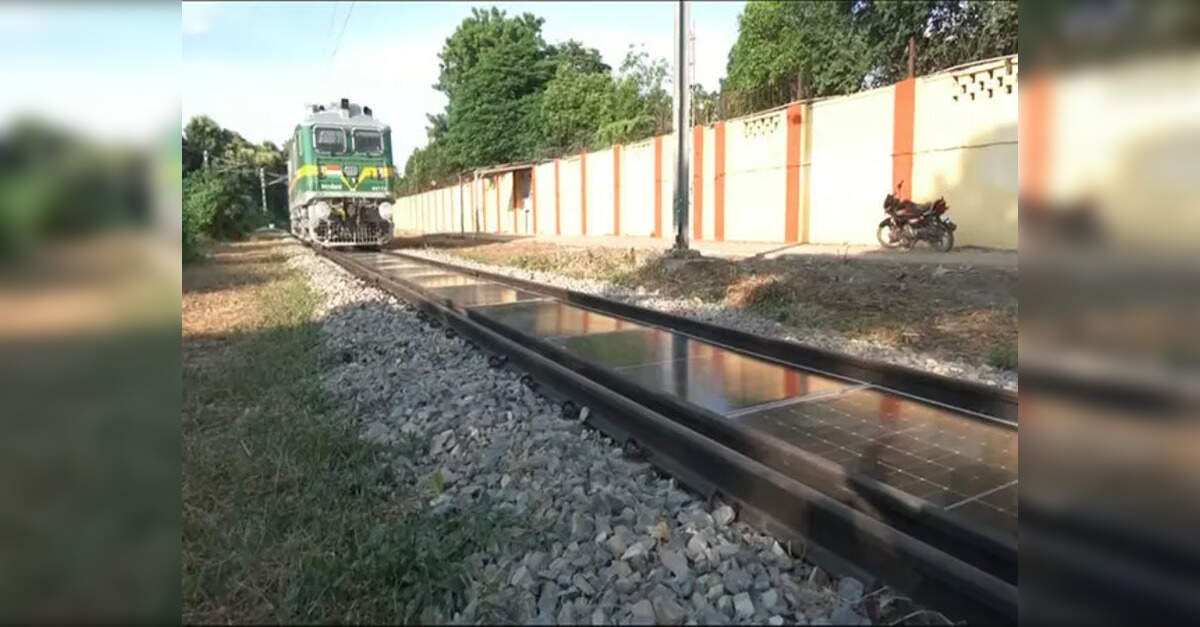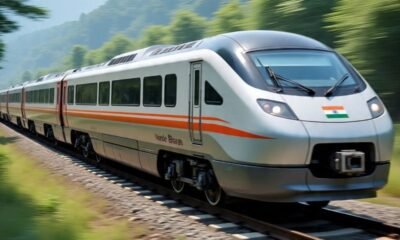Rail & Road
Banaras Locomotive Works installs solar panels on tracks, focuses on green energy, ETInfra

New Delhi: In a significant step towards sustainable rail operations, Banaras Locomotive Works (BLW) has become the first unit in Indian Railways to install solar panels between operational railway tracks.
The innovation, described as a milestone in the national transporter’s renewable energy mission, highlights BLW’s growing focus on green energy and environmental conservation.
BLW General Manager Naresh Pal Singh said the project is part of the unit’s broader plan to reduce dependence on conventional energy.
“We generate 4.5 megawatt of solar energy, which meets nearly 20 percent of our power requirement. Solar panels have been installed not only on rooftops but also innovatively on tracks,” he said.
The Varanasi-based production unit, which manufactures both diesel and electric locomotives, has steadily shifted focus since the government’s policy decision on 100 per cent electrification.
“Today, most of the diesel locomotives we build are meant for exports or non-railway customers. So far, BLW has exported 174 locomotives and supplied 641 units to non-railway clients,” Singh said.
In total, the unit has produced over 10,800 locomotives, including 8,300 diesel models.
Just last month, BLW flagged off its 2,500th electric locomotive. Looking ahead, the unit is preparing to manufacture the new generation of Amrit Bharat locomotives-24 units this year and 48 next year. Singh added that BLW is expanding into allied services such as diesel loco servicing and wheel servicing to strengthen its profitability.
On the environmental front, BLW is already a “zero-discharge unit.” Water is treated and reused, while rainwater harvesting systems ensure long-term conservation. Nearly 40 percent of the premises is forested area, with 1.5 lakh trees planted. “This year, we will add 5,000 more trees,” Singh said.
The combination of solar expansion, water conservation, and afforestation makes BLW a leading example of how Indian Railways is aligning industrial growth with sustainability goals.
–IANS
sas/pgh
Rail & Road
Texmaco-RVNL JV to boost rail infrastructure; Texmaco holds 49%, RVNL 51% – Industry News

Texmaco Rail & Engineering (TREL) has announced a new joint venture with Navratna PSU Rail Vikas Nigam (RVNL) to expand its presence in the rail infrastructure sector. Under the agreement, RVNL will hold a 51 per cent stake in the new entity, while Texmaco will own the remaining 49 per cent. The JV is expected to close by December 31, 2025, subject to regulatory approvals.
JV to manufacture and maintain freight and passenger rolling stock
The joint venture company will focus on the manufacturing and maintenance of freight and passenger rolling stock, including locomotives, wagons, coaches, trainsets, metro coaches and specialized equipment.
It will also take part in domestic and international tenders and execute engineering, procurement, and construction (EPC) projects in the railway sector. The company plans to operate and maintain railway workshops, depots, and sheds as part of its business model.
Texmaco invests Rs 49 crore to acquire 49% stake
Texmaco, part of the Adventz Group, will acquire its 49 per cent stake through a cash investment of Rs 49 crore. “The JV will leverage the complementary strengths of both TREL and RVNL to pursue mutually beneficial business opportunities in the railway sector,” the company said in its filing.
Collaboration aligns with Make in India and green mobility initiatives
Adventz Group chairman Saroj Kumar Poddar said the JV will expand India’s capacity to deliver world-class rail infrastructure, as per a PTI report. “It will open doors for innovation, exports and digital technologies, making Indian railways globally competitive while supporting the country’s self-reliance journey,” he said.
According to PTI, Texmaco MD Sudipta Mukherjee said, “We will deliver next-generation freight, passenger and metro systems that advance Atmanirbhar Bharat and put India on the global rail map.” RVNL chairman and managing director Pradeep Gaur said the collaboration supports the government’s Make in India and green mobility push.
Texmaco, headquartered in Kolkata, runs seven manufacturing units across West Bengal, Gujarat and Chhattisgarh. It supplies freight cars to Indian Railways, private clients and overseas buyers, and has joint ventures with global firms such as Wabtec and Touax.
Rail & Road
Two Major Railroads Reject Consolidation as Union Pacific Pursues $85 Billion Deal

Two of North America’s most prominent freight rail companies have withdrawn from the wave of merger speculation that has dominated the industry in recent weeks, a development that could reshape the outlook for Union Pacific’s proposed $85 billion deal with Norfolk Southern.
Rail & Road
Hitachi Rail partners with Ontario Tech University

Hitachi Rail has signed a Memorandum of Understanding (MoU) with Ontario Tech University to support the launch of Canada’s first undergraduate Railway Engineering Specialisation. Beginning in September 2025, the programme aims to address the growing demand for skilled professionals in Canada’s rail sector, providing students with both academic training and industry experience.
The MoU was signed by Ziad Rizk, Managing Director of Hitachi Rail Canada, and Dr Hossam Kishawy, Dean of the Faculty of Engineering and Applied Science at Ontario Tech University. Under the agreement, Hitachi Rail will contribute to curriculum development, offer student placements, and explore opportunities for joint research.
Students enrolled in the specialisation will gain exposure to areas such as railway systems, safety and signalling, rolling stock, operations, and maintenance. They will also benefit from guest lectures and mentoring provided by Hitachi Rail experts.
Ziad Rizk said:
“This is an exciting opportunity for Hitachi Rail to partner with Ontario Tech University and for the students to leverage experiences from this partnership. Bridging the gap between industry and classroom will shape a workforce trained and ready to meet real-world challenges. We are greatly looking forward to having the chance to contribute to this discipline and provide opportunities for aspiring engineers in the Canadian rail sector.”
A first for Canada
The specialisation will be available to third- and fourth-year students in Manufacturing, Automotive, Mechatronics, and Mechanical Engineering programmes, with Software and Electrical Engineering students able to take courses as electives. It is Canada’s only English-language undergraduate railway engineering programme, preparing students for careers in rail electrification, automation, and climate-resilient infrastructure.
Dr Hossam Kishawy commented:
“Ontario Tech is proud to be home to Canada’s only English-language undergraduate Railway Engineering specialisation, preparing students with the skills industry needs most—rail electrification, automation, and climate-resilient infrastructure. Our new partnership with Hitachi Rail strengthens this mission, ensuring our students gain exposure to global expertise while helping industry address critical workforce needs.”
Supporting Ontario’s transit expansion
The partnership comes as Ontario undertakes the largest transit expansion in North America, supported by a provincial CAD 70 billion investment in public transport. Projects include the expansion of GO Transit, restoration of passenger rail to northern Ontario, and the construction of the Ontario Line subway.
Prabmeet Sarkaria, Ontario’s Minister of Transportation, said:
“Ontario has launched the largest transit expansion in North America, and this first-of-its-kind railway engineering programme will ensure our province has the talent it needs to deliver game-changing rail infrastructure. Our GO Expansion plan includes the Bowmanville Extension, which will make it easier for post-secondary students to access Ontario Tech University’s campus in Oshawa.”
Nolan Quinn, Ontario’s Minister of Colleges, Universities, Research Excellence and Security, added:
“Ontario’s world-class postsecondary education institutions are building a robust engineering workforce of the future. Our government commends this innovative partnership between Ontario Tech and Hitachi Rail, enabling students enrolled in the Railway Engineering Specialisation to get the education and hands-on training they need to keep Ontario moving for decades to come.”
Hitachi Rail has operated in Toronto for more than 40 years and currently employs around 1,200 people in Ontario.
-

 Brand Stories1 month ago
Brand Stories1 month agoBloom Hotels: A Modern Vision of Hospitality Redefining Travel
-

 Brand Stories1 month ago
Brand Stories1 month agoCheQin.ai sets a new standard for hotel booking with its AI capabilities: empowering travellers to bargain, choose the best, and book with clarity.
-

 Destinations & Things To Do1 month ago
Destinations & Things To Do1 month agoThis Hidden Beach in India Glows at Night-But Only in One Secret Season
-

 Destinations & Things To Do1 month ago
Destinations & Things To Do1 month agoUntouched Destinations: Stunning Hidden Gems You Must Visit
-

 AI in Travel1 month ago
AI in Travel1 month agoAI Travel Revolution: Must-Have Guide to the Best Experience
-

 Family Travel2 months ago
Family Travel2 months agoThings to Do Indoors in New Jersey
-

 Brand Stories2 months ago
Brand Stories2 months agoVoice AI Startup ElevenLabs Plans to Add Hubs Around the World
-

 Brand Stories1 month ago
Brand Stories1 month agoContactless Hospitality: Why Remote Management Technology Is Key to Seamless Guest Experiences
-

 Restaurants & Food5 months ago
Restaurants & Food5 months ago10 New Restaurants In Delhi NCR To Head To This Month
-

 Brand Stories2 months ago
Brand Stories2 months agoHow Elon Musk’s rogue Grok chatbot became a cautionary AI tale













You must be logged in to post a comment Login